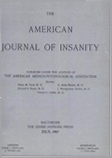BROMIDE DELIRIUM AND OTHER BROMIDE PSYCHOSES
Abstract
Seven cases of bromide delirium and one case of bromide hallucinosis are presented. In addition to the commonly known symptoms of delirium, the patients in the delirious group showed to a noteworthy extent two disturbances. (1) Disturbances of sensation (referring not to hallucinations, but to subjective difficulty in recognizing colors, macropsia, micropsia, etc.). (2) Disturbances of the association of ideas of the type commonly seen in schizophrenia. It is suggested that these two disturbances are among the "ingredients" of disorientation. The delirious individual misidentifies objects and situations partly because he does not perceive well and partly because, owing to faulty association of ideas, he improperly discriminates that which he has perceived.
Consideration is given to the following topics:
(1) How many clinical types of bromide psychosis are known to exist? We may say with certainty that in addition to "simple bromide intoxication" there are delirium and hallucinosis. There seems to be a possibility that bromide intoxication may also manifest itself as a paranoid state. In two of my cases (Cases 2 and 7) the delirium merged into a transitory paranoid state. In neither of these cases was there evidence of a paranoid state prior to the delirium. In another case (Case 4) the delirium merged into a paranoid state which, at the present writing, has been in existence over 11 months without yet having begun to subside; in this case the patient had a major psychosis before the onset of the delirium, and the existence of paranoid symptoms prior to the delirium has not been ruled out. As far as I know, no case has been reported in which a paranoid state supervened during bromide intoxication without a previous delirium.
The distinction between "paranoid disorientation" and delirious disorientation is demonstrated.
(2) Is there a "post-intoxication psychosis"? The possibility of this is suggested by Case 5, in which a woman, previously nonpsychotic, developed a bromide delirium which, four weeks after the discontinuance of bromides, merged into a chronic delirium with marked psychomotor embarrassment. It seems possible that under certain conditions bromide intoxication (like any other toxic process) may precipitate a chronic psychosis which remains long after the intoxication has subsided.
(3) The etiological factors of bromide psychoses are reviewed. Attention is called to several objections to the recently proposed hypothesis of the occurrence of "withdrawal delirium."
Access content
To read the fulltext, please use one of the options below to sign in or purchase access.- Personal login
- Institutional Login
- Sign in via OpenAthens
- Register for access
-
Please login/register if you wish to pair your device and check access availability.
Not a subscriber?
PsychiatryOnline subscription options offer access to the DSM-5 library, books, journals, CME, and patient resources. This all-in-one virtual library provides psychiatrists and mental health professionals with key resources for diagnosis, treatment, research, and professional development.
Need more help? PsychiatryOnline Customer Service may be reached by emailing [email protected] or by calling 800-368-5777 (in the U.S.) or 703-907-7322 (outside the U.S.).



